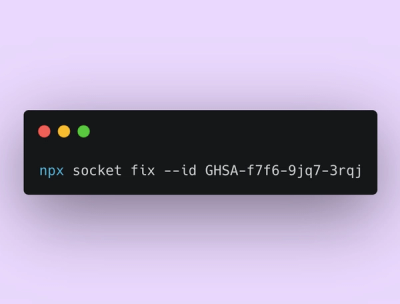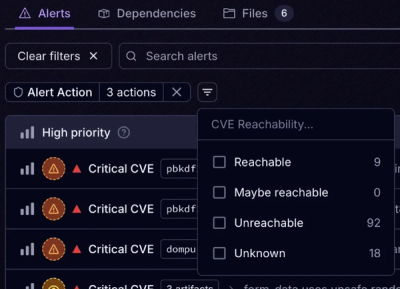
Product
Announcing Socket Fix 2.0
Socket Fix 2.0 brings targeted CVE remediation, smarter upgrade planning, and broader ecosystem support to help developers get to zero alerts.
Based on https://github.com/tillbaks/node-eiscp.
This is a node module to control and interact with Onkyo receivers over the network.
Basically it is a merge of my previous module which was really simple and https://github.com/miracle2k/onkyo-eiscp translated to javascript, which means a lot more features but some stuff still missing like handling multiple receivers and special commands (ranges are supported though).
{
"dependencies": {
"eiscp": "eiscp"
}
}
https://github.com/estbeetoo/eiscp.js/tree/master/examples
Same syntax as https://github.com/miracle2k/onkyo-eiscp thanks dude!
See example 3.js to retreive an array of all available commands
A command consists of three parts: The zone, the command, and the arguments. Here are some examples::
system-power=on
zone2.power=on
main.balance=3
As you can see, the basic format is::
zone.command=argument
If you do not specify a zone, then main is assumed.
There are some variations on this syntax that are possible, for example the following are all equivalent::
power on
power:on
main.power on
main power on
In other words, instead of the . and = separators, whitespace may
be used, and the colon : is an alternative to =. However, it's best
to use the suggested syntax above.
You will to listen to events to use this module.
Data from connected receiver.
command: (string) - Any supported command like "volume" or "system-power"
callback: (function) - One argument containing the result of the command. If command is volume you would get the volume as a number.
Data from connected receiver.
data:
Will fire when connected.
Will fire when disconnected.
Will fire when error is encountered.
message: (string) - contains an error message
Will fire when debug message is encountered. Use this when developing, you will get useful messages for debugging.
message: (string) - contains a debug message
If you only have one receiver on your network there is no need to provide any options, it will be discovered automatically.
options:
host (default: undefined) - Hostname or IP of receiverport (default: 60128) - Port of receiverreconnect (default: true) - Reconnect to receiver if connection is lostreconnect_sleep (default: 5) - Time in seconds between reconnection attemptsverify_commands (default: true) - Whether to verify high-level commands for model compatibilitySends a broadcast packet and waits for response
options:
address (default: "255.255.255.255") - Hostname or IP of receiverport (default: 60128) - Listening port (NOTE: try changing this if you have trouble connecting)timeout (default: 2) - Time in seconds to wait for respoonses after broadcast is sentcallback: (function) - You will receive one argument cointaining an array of devices
devices (array) - An array of objects
host - Receiver IPport - Receiver Portmodel - Receiver Modelareacode - Area Code?message - Raw message that was receivedSends a low-level command like PWR01 or MVL1A
data: (string) - Command to send
callback:
NOTE: Callback does not tell you if the command was successfull only that it was sent to the receiver.
result (object)
result - true or false if command was sent to receivermsg - If there is a message attached to the resultSends a high-level command like system-power=query or zone2.volume=1A more info about command syntax can be found above the API
command: (string) - Command to send
callback:
NOTE: Callback does not tell you if the command was successfull only that it was sent to the receiver.
result (object)
result - true or false if command was sent to receivermsg - If there is a message attached to the resultRetreives an array of all commands in the provided zone
zone: (string) - zone can be "main", "zone2" etc..
callback:
commands (array) - Array of all commandsRetreives an array of all arguments in the provided command
command: (string) - command can be "system-power", "zone2.volume" etc.. (NOTE: If you don't specify zone "main" will be assumed)
callback:
arguments (array) - Array of all argumentsAll commands are in a json file "eiscp-commands.json" and are converted from a YAML file from https://github.com/miracle2k/onkyo-eiscp thanks dude!
wget https://raw.github.com/miracle2k/onkyo-eiscp/master/eiscp-commands.yaml
Run in node-eiscp directory. This will create "eiscp-commands.json". Warning this script might be badly coded. [:
node eiscp-commands-convert.js
FAQs
interface to onkyo (integra) receivers / eiscp protocol
The npm package eiscp receives a total of 12 weekly downloads. As such, eiscp popularity was classified as not popular.
We found that eiscp demonstrated a not healthy version release cadence and project activity because the last version was released a year ago. It has 1 open source maintainer collaborating on the project.
Did you know?

Socket for GitHub automatically highlights issues in each pull request and monitors the health of all your open source dependencies. Discover the contents of your packages and block harmful activity before you install or update your dependencies.

Product
Socket Fix 2.0 brings targeted CVE remediation, smarter upgrade planning, and broader ecosystem support to help developers get to zero alerts.

Security News
Socket CEO Feross Aboukhadijeh joins Risky Business Weekly to unpack recent npm phishing attacks, their limited impact, and the risks if attackers get smarter.

Product
Socket’s new Tier 1 Reachability filters out up to 80% of irrelevant CVEs, so security teams can focus on the vulnerabilities that matter.